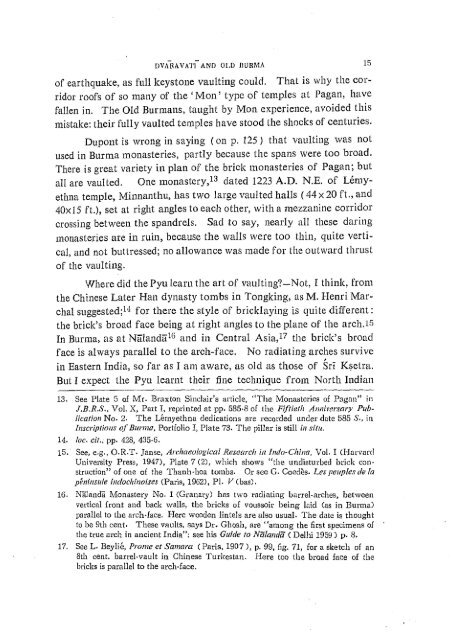The Journal of the Siam Society Vol. LIII, Part 1-2, 1965 - Khamkoo
The Journal of the Siam Society Vol. LIII, Part 1-2, 1965 - Khamkoo
The Journal of the Siam Society Vol. LIII, Part 1-2, 1965 - Khamkoo
You also want an ePaper? Increase the reach of your titles
YUMPU automatically turns print PDFs into web optimized ePapers that Google loves.
DVAilAVATI- AND OLD BURMA 15<br />
<strong>of</strong> earthquake, as full keystone vaulting could. That is why <strong>the</strong> cor~<br />
ridor ro<strong>of</strong>s <strong>of</strong> so many <strong>of</strong> <strong>the</strong>' Mon' type <strong>of</strong> temples at Pagan, have<br />
fallen in. <strong>The</strong> Old Bm·mans, taught by Mon experience, avoided this<br />
mistake: <strong>the</strong>ir fully vaulted temples have stood Lhe shocks <strong>of</strong> centuries.<br />
Dupont is wrong in saying (on p. 125) that vaulting was not<br />
used in Burma monasteries, partly because <strong>the</strong> spans were too broad.<br />
<strong>The</strong>re is great variety in plan <strong>of</strong> <strong>the</strong> brick monasteries <strong>of</strong> Pagan; but<br />
all are vaulted. One monastery, 13 dated 1223 A.D. N.E. <strong>of</strong> Lemy~<br />
ethna temple, Minnanthu, has two large vaulted halls ( 44 x 20ft., and<br />
40x 15 ft.), set at right angles to each o<strong>the</strong>r, with a mezzanine corridor<br />
crossing between <strong>the</strong> spandrels. Sad to say, nearly all <strong>the</strong>se daring<br />
monasteries are in ruin, because <strong>the</strong> walls were too thin, quite verti~<br />
cal, and not buttressed; no allowance was made for <strong>the</strong> outward thrust<br />
<strong>of</strong> <strong>the</strong> vaulting.<br />
Where did <strong>the</strong> Pyu learn <strong>the</strong> art <strong>of</strong> vaulting?-Not, I think, from<br />
<strong>the</strong> Chinese Later Han dynasty tombs in Tongking, as M. Henri Mar~<br />
chal suggested;14 for <strong>the</strong>re <strong>the</strong> style <strong>of</strong> bricklaying is quite different:<br />
<strong>the</strong> brick's broad face being at right angles to <strong>the</strong> plane <strong>of</strong> <strong>the</strong> arch.l5<br />
In Burma, as at Ni.i'landa 16 and in Central Asia,17 <strong>the</strong> brick's broad<br />
face is always parallel to <strong>the</strong> arch-face. No radiating arches survive<br />
in Eastern India, so far as I am aware, as old as those <strong>of</strong> Sri Ksetra.<br />
But I expect <strong>the</strong> Pyu learnt <strong>the</strong>ir fine technique from North Indian<br />
13. See Plate 5 <strong>of</strong> Mr. Braxton Sinclair's article, "<strong>The</strong> Monasteries <strong>of</strong> Pagan" in<br />
J.B.R.S., <strong>Vol</strong>. X, <strong>Part</strong> T, reprinted at pp. 585·8 <strong>of</strong> <strong>the</strong> Fiftieth Anniversary Publication<br />
No. 2. <strong>The</strong> Lernyethna dedications are recorded under date 585 s., in<br />
Inscriptions <strong>of</strong> Burma, Portfolio I, Plate 73. <strong>The</strong> pillar is still in situ.<br />
14. lac. cit .. PP· 428, 435-6.<br />
15. See, e.g., Q.R.T. Janse, Archaeological Research iulndo-China, <strong>Vol</strong>. I (f-Jarvard<br />
University Press, 1947), Plate 7 (2), which shows "<strong>the</strong> undisturbed brick con·<br />
struction" <strong>of</strong> one <strong>of</strong> <strong>the</strong> Thanh·hoa tombs. Or see G. Coedes. Les pe11p!es de fa<br />
peninsule indochinoises (Paris, 1962), Pl. V Cbas).<br />
16. Nalanda Monastery No. 1 (Granary) has two radiating barreJ.arches, between<br />
vertical front and back walls, <strong>the</strong> bricks <strong>of</strong> voussoir being laid Cas in Burma)<br />
parallel to <strong>the</strong> arch·face. Here wooden lintels are also usual. <strong>The</strong> date is thought<br />
to be 9th cent. <strong>The</strong>se vaults, says Dr. Ghosh, are "among <strong>the</strong> first specimens <strong>of</strong><br />
<strong>the</strong> true arch in ancient India": see his Guide to Nalanda ( Delhi 1959) p. 8.<br />
17. See L. Bey lie, Prome et Samara (Paris, 1907 ), p. 99, flg. 71, for a sketch <strong>of</strong> an<br />
8th cent. burrel-vault in Chinese Turkestan. Here too <strong>the</strong> broad face <strong>of</strong> <strong>the</strong><br />
bricks is parallel to <strong>the</strong> arch-face.

















